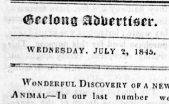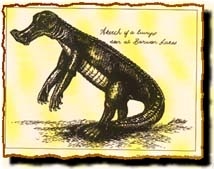Bundjil | Land cultivation | Shelter | The Bunyip | Weapons and utensils | Willem Baa Ni ip | Dan Dan Nook | You Yangs | Barwon River | Lara | Bells Beach
The first use of the word bunyip in a written publication appears to be in The Geelong Advertiser and Squatters' Advocate on the 2nd July 1845 (page 2) when fossils were found near Djillong (Geelong).
The headline read: Wonderful Discovery of a new Animal.

The article reported an interview with a Wathaurong man in this way:

It also reported a story of an Aboriginal woman being killed by a bunyip, and the "most direct evidence of all," which was that of a man named Mumbowran, "who showed several deep wounds on his breast made by the claws of the animal."
The animal was described in this way:
William Buckley is also said to have written about the Bunyip in his 1852 biography about his 30 years of living with the Wathaurong people.
He wrote:
"in... Lake Moodewarri [now Lake Modewarre] as well as in most of the others inland...is a...very extraordinary amphibious animal, which the natives call Bunyip." ... "I could never see any part, except the back, which appeared to be covered with feathers of a dusky grey colour. It seemed to be about the size of a full grown calf... I could never learn from any of the natives that they had seen either the head or tail."
According to Wikipedia, Buckley also claimed the creature was common in the Barwon River and cites an example he heard of an Aboriginal woman being killed by one. He emphasized the Bunyip was believed to have supernatural powers.
Provided by Uncle David Tournier

